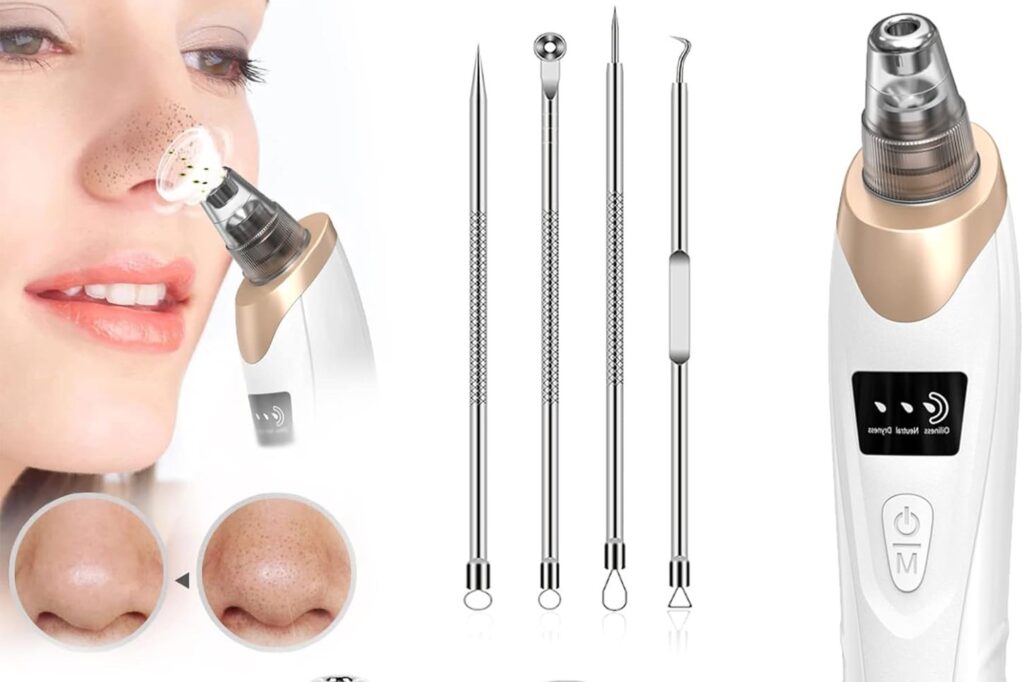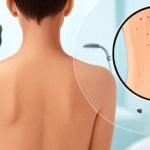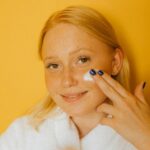The beauty industry is constantly evolving with new gadgets promising clearer, smoother skin. One device that has gained significant attention is the blackhead vacuum, also known as a pore vacuum or suction device. These handheld tools claim to extract blackheads, remove debris, and leave your pores looking cleaner than ever. But do they actually work, or are they just another skincare gimmick that could potentially harm your skin?
In this comprehensive guide, we’ll dive deep into the world of blackhead vacuums, examining their effectiveness, safety concerns, and whether they’re worth adding to your skincare routine. We’ll also explore alternative methods for blackhead removal and provide expert insights to help you make an informed decision.
What Is a Blackhead Vacuum?
A blackhead vacuum is a small, handheld electronic device that uses suction to extract oil, dead skin cells, and other debris from your pores. These devices typically come with multiple attachments and adjustable suction levels, allowing users to customize their treatment based on their skin type and needs.
Types of Blackhead Vacuums
There are two main categories of pore vacuum devices:
Professional-Grade Devices:
- Used in dermatology offices and medical spas
- FDA-approved for cosmetic use
- Higher suction power with precise control
- Operated by trained professionals
- Cost ranges from $200-$500 per treatment
At-Home Consumer Devices:
- Available for purchase online and in stores
- Price range: $10-$100
- Variable quality and suction power
- Self-operated with basic instructions
- No professional oversight
How Do Blackhead Vacuums Work?
The concept behind blackhead vacuums is relatively simple. The device creates negative pressure (suction) that theoretically pulls out the contents of clogged pores. Most devices come with different sized tips:
- Large circular tips: For broader areas like cheeks and forehead
- Small oval tips: For targeted extraction around the nose
- Micro tips: For precise work on individual blackheads
Does a Blackhead Vacuum Really Work?
The effectiveness of blackhead vacuums is a topic of considerable debate among skincare professionals. Here’s what the research and expert opinions reveal:
Limited Effectiveness on Stubborn Blackheads
According to Dana Rice, a master esthetician, “At-home pore vacuuming devices have only shown to help with blackheads that are already loosened in the skin.” This means that the device works best as a finishing step rather than a primary blackhead removal method.
Dr. Hadley King, a board-certified dermatologist in New York City, explains that blackhead vacuums can be somewhat effective, but only under specific conditions:
- The blackhead must already be softened or loosened
- Pre-treatment with steam or chemical exfoliants is essential
- The suction level must be appropriate for your skin type
- Proper technique and timing are crucial
The Reality Check
While blackhead vacuums can provide some immediate satisfaction by removing surface-level debris, they have several limitations:
What They Can Do:
- Remove loose debris from pore openings
- Extract already-loosened blackheads
- Provide temporary improvement in pore appearance
- Remove excess oil from the skin surface
What They Cannot Do:
- Permanently shrink pore size
- Remove deep-seated blackheads without preparation
- Prevent future blackhead formation
- Address underlying causes of acne
Skin Type Considerations
The effectiveness of blackhead vacuums varies significantly based on skin type:
Oily Skin:
- May see more noticeable results due to excess sebum production
- Higher risk of over-extraction and irritation
- Requires lower suction settings
Dry/Sensitive Skin:
- Limited effectiveness due to less surface debris
- Higher risk of damage and irritation
- May not be suitable for regular use
Combination Skin:
- Results vary by facial zone
- T-zone may respond better than cheek areas
- Requires careful adjustment of suction levels
Are There Any Risks to Consider?
While blackhead vacuums may seem harmless, they carry several potential risks, especially when used incorrectly or too frequently.
Common Side Effects
Bruising and Discoloration:
- Most common side effect of excessive suction
- Can last several days to weeks
- More likely with sensitive skin types
- May result in temporary hyperpigmentation
Broken Blood Vessels (Telangiectasias):
- Permanent damage to small facial capillaries
- Appears as red spider-like marks
- Particularly common around the nose area
- Requires professional treatment to address
Micro-Tears and Skin Damage:
- Invisible damage to the skin barrier
- Can lead to increased sensitivity
- May cause delayed healing and scarring
- Increases risk of bacterial infection
Specific Risk Factors
Pre-existing Skin Conditions:
- Rosacea sufferers should avoid these devices entirely
- Active acne may worsen with suction
- Eczema-prone skin is at higher risk for irritation
Medication Interactions:
- Retinoid users have increased skin sensitivity
- Blood-thinning medications increase bruising risk
- Recent chemical peels or laser treatments contraindicate use
Professional vs. At-Home Safety
The safety profile differs significantly between professional and at-home treatments:
Professional Treatment Safety:
- Trained operators assess skin condition
- Medical-grade equipment with precise controls
- Immediate access to treatment for adverse reactions
- Proper pre and post-treatment care
At-Home Device Risks:
- No professional assessment of skin suitability
- Variable device quality and safety standards
- User error in technique and pressure application
- Limited recourse for adverse reactions
Step-by-Step Guide: How to Use a Blackhead Vacuum Safely
If you decide to try a blackhead vacuum at home, following proper technique is crucial for both effectiveness and safety.
Pre-Treatment Preparation
- Cleanse thoroughly: Use a gentle cleanser to remove makeup and surface dirt
- Steam your face: Apply warm, damp towel for 5-10 minutes to soften blackheads
- Optional chemical prep: Apply a BHA (salicylic acid) product 15-20 minutes before treatment
- Test the device: Start with the lowest suction setting on a small area
During Treatment
- Start conservatively: Begin with the gentlest setting
- Keep it moving: Never hold the device in one spot for more than 2-3 seconds
- Work systematically: Move from less sensitive to more sensitive areas
- Monitor your skin: Stop immediately if you see redness or feel pain
- Limit treatment time: Total session should not exceed 10-15 minutes
Post-Treatment Care
- Apply a soothing toner: Use alcohol-free, anti-inflammatory ingredients
- Moisturize immediately: Restore the skin barrier with a gentle moisturizer
- Avoid harsh products: Skip retinoids, AHAs, and BHAs for 24-48 hours
- Use sunscreen: Treated skin may be more photosensitive
Alternative Methods for Blackhead Removal
Given the limitations and risks of blackhead vacuums, many dermatologists recommend alternative approaches that are both safer and more effective long-term.
Chemical Exfoliants
Salicylic Acid (BHA):
- Oil-soluble, penetrates deep into pores
- Dissolves sebum and dead skin cells
- Available in concentrations from 0.5% to 2%
- Suitable for daily use with proper introduction
Glycolic Acid (AHA):
- Water-soluble, works on skin surface
- Helps with overall skin texture and tone
- May help prevent future blackhead formation
- Best used 2-3 times per week
Retinoids
Over-the-Counter Options:
- Retinol and retinyl palmitate
- Gentle introduction recommended
- Helps normalize skin cell turnover
- Prevents pore clogging
Prescription Strength:
- Tretinoin, adapalene, tazarotene
- More potent and faster results
- Requires dermatologist supervision
- May cause initial purging period
Professional Treatments
Manual Extraction:
- Performed by licensed estheticians or dermatologists
- Uses proper tools and technique
- Immediate results with minimal risk
- Cost: $75-$150 per session
Chemical Peels:
- Professional-strength acids
- Addresses multiple skin concerns simultaneously
- Requires downtime but provides lasting results
- Cost: $100-$300 per treatment
Microdermabrasion:
- Physical exfoliation using crystals or diamond tips
- Improves overall skin texture
- Minimal downtime
- Cost: $100-$200 per session
At-Home Clay Masks
Bentonite Clay:
- Absorbs excess oil and impurities
- Gentle enough for weekly use
- Affordable and widely available
- Can be mixed with other beneficial ingredients
Kaolin Clay:
- Suitable for sensitive skin types
- Less drying than bentonite
- Provides gentle pore cleansing
- Often combined with other active ingredients
Cost Analysis: Professional vs. At-Home Treatments
Understanding the financial investment can help you make an informed decision about blackhead removal methods.
At-Home Blackhead Vacuum Costs
Initial Investment:
- Basic devices: $10-$30
- Mid-range options: $30-$60
- High-end consumer models: $60-$100
Ongoing Costs:
- Replacement tips: $5-$15 every 3-6 months
- Cleaning solutions: $10-$20 annually
- Potential skin damage treatment: $50-$500+
Professional Treatment Costs
Single Session Pricing:
- Basic extraction: $75-$100
- Extraction with facial: $100-$150
- Medical-grade vacuum treatment: $150-$300
Package Deals:
- 3-session packages: 10-15% discount
- 6-session packages: 15-20% discount
- Annual maintenance plans: 20-25% discount
Long-Term Value Comparison
When considering long-term value, professional treatments often provide better results per dollar spent, especially when factoring in:
- Reduced risk of skin damage
- More effective blackhead removal
- Professional skin assessment and advice
- Access to medical-grade products and equipment
Prevention: The Best Long-Term Strategy
Rather than focusing solely on blackhead removal, developing a prevention-focused skincare routine provides the most sustainable results.
Daily Skincare Routine
Morning:
- Gentle cleanser
- BHA toner (2-3 times per week)
- Lightweight, non-comedogenic moisturizer
- Broad-spectrum SPF 30+ sunscreen
Evening:
- Double cleanse (oil cleanser followed by water-based cleanser)
- Retinoid product (start 2-3 times per week)
- Hydrating serum
- Non-comedogenic night moisturizer
Lifestyle Factors
Diet Considerations:
- Limit high-glycemic foods
- Reduce dairy consumption if sensitive
- Increase omega-3 fatty acids
- Stay adequately hydrated
Environmental Factors:
- Regular pillowcase changes
- Clean makeup brushes weekly
- Avoid touching face throughout the day
- Use non-comedogenic makeup and skincare products
Frequently Asked Questions
How often can I use a blackhead vacuum?
Most dermatologists recommend limiting blackhead vacuum use to once every 1-2 weeks maximum. Overuse can lead to skin irritation, broken capillaries, and compromised skin barrier function. Always allow your skin to fully recover between sessions.
Can blackhead vacuums cause permanent skin damage?
Yes, improper use of blackhead vacuums can cause permanent damage including broken blood vessels (telangiectasias), scarring, and hyperpigmentation. These effects are more likely with high suction settings, prolonged use in one area, or use on compromised skin.
Are blackhead vacuums safe for sensitive skin?
Blackhead vacuums are generally not recommended for sensitive skin types. Those with rosacea, eczema, or easily irritated skin should avoid these devices entirely. If you have sensitive skin and want to try pore extraction, consult with a dermatologist for safer alternatives.
Can I use a blackhead vacuum on active pimples?
No, blackhead vacuums should never be used on active pimples, inflamed acne, or broken skin. This can worsen inflammation, spread bacteria, and potentially cause scarring. Only use these devices on non-inflamed blackheads and comedones.
Do I need to moisturize after using a blackhead vacuum?
Yes, moisturizing after using a blackhead vacuum is essential. The suction process can disrupt your skin’s natural barrier, leading to dryness and irritation. Apply a gentle, non-comedogenic moisturizer immediately after treatment to help restore and protect your skin.
What’s the difference between blackheads and sebaceous filaments?
Blackheads are actual clogged pores filled with oxidized sebum and dead skin cells, appearing dark or black. Sebaceous filaments are normal structures that help oil flow through pores and appear as small, grayish dots. Blackhead vacuums may temporarily remove sebaceous filaments, but they’ll return quickly as they’re a normal part of skin function.
The Bottom Line: Should You Try a Blackhead Vacuum?
After examining the evidence, expert opinions, and potential risks, the answer to whether you should try a blackhead vacuum depends on several factors:
Consider trying a blackhead vacuum if:
- You have mild, surface-level blackheads
- Your skin is not sensitive or reactive
- You’re willing to invest time in proper technique and preparation
- You understand the limitations and temporary nature of results
- You can afford potential treatment costs for adverse effects
Skip the blackhead vacuum if:
- You have sensitive, rosacea-prone, or easily irritated skin
- You’re currently using retinoids or have recently had professional treatments
- You’re looking for a permanent solution to blackheads
- You’re not comfortable with the potential risks
- You prefer evidence-based, dermatologist-recommended treatments
The Professional Recommendation:
Most dermatologists and skincare professionals lean toward recommending proven alternatives like chemical exfoliants, retinoids, and professional extractions over at-home blackhead vacuums. These methods offer better long-term results with lower risk profiles.
If you’re serious about addressing blackheads and improving your skin’s overall health, consider investing in a comprehensive skincare routine that includes:
- Daily gentle cleansing
- Regular chemical exfoliation with BHA
- Retinoid products for long-term pore health
- Professional treatments as needed
- Consistent sun protection
Remember, healthy skin is a long-term commitment, not a quick fix. While blackhead vacuums might provide temporary satisfaction, building a solid skincare foundation will give you better, more sustainable results for years to come.
Ready to take the next step in your skincare journey? Consider scheduling a consultation with a board-certified dermatologist who can assess your specific skin needs and recommend the most effective treatment plan for your individual concerns. Your skin deserves professional care and evidence-based solutions that will keep it healthy and radiant for the long term.



